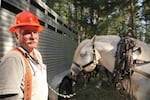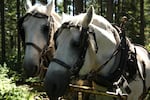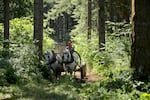Jamming a metal skidding tong into a log, Roger Daugherty draws the slack from his driving reigns and clicks to his team of dappled Percheron draft horses, Willee and Charlie.
“Wake up there, Willee,” he chides. “C'mon now, just a little bit, just a little.”
The team snorts and steps. The log jerks forward and begins to slide.
Roger is a horse logger, a vocation that stretches back to the beginning of Oregon’s logging history. But it is a slow and labor-intensive way to drag logs from the woods. It requires not only all the skills and demands of logging, but also the knowledge and temperament to work with horses.
Horse logging had a brief golden era in the 1970s, when Roger graduated from Oregon State University. In 1974, the year Roger started out, a report published by the Oregon State Department of Forestry listed 34 horse loggers in Oregon.
"It was on the tail end of the old growth economy," explains Harry Lehman, former NW Director of the North American Horse and Mule Loggers Association.
"The timber companies didn't want to touch the 'dog hair' timber." [stands of trees too tightly packed and spindly to be considered commercially valuable.] This created an economic opening for horse loggers to cut and pull these smaller-diameter trees, which is what horse logging is best suited for.
But with advances in technology, smaller-diameter timber can now be harvested more economically with machines than with horses.
The generation of horse loggers of the 1970s that mentored Roger has retired or passed away. In fact, according to the Associated Oregon Loggers, Roger may be the last active professional horse logger in Oregon.

Roger Daugherty, professional horse logger
Ian McCluskey / OPB
Today, Roger has been called back to a family forest that he has been logging for nearly 45 years, with its own connection to Oregon’s logging history.
This 325-acre property was purchased in 1960 by forester Wendell Harmon, an early advocate of what is now known as "selective thinning."
Nearly 60 years later, his son Dave Harmon walks the woods with a wooden measuring stick and a can of blue spray paint, just as his father once did.
Roger joins Dave as they hike the forest, selecting which trees to mark for cutting.
Dave stops and looks up at the tree canopy. One tree leans crooked, and crowds two neighbors.
He measures with his Biltmore stick. “This is 24 inches,” he says. “I’m gonna take this out 'cause it’s rough.”
"Yeah,” Roger agrees. “It’d definitely help release those.”
Release was a favorite word of Wendell’s. “That was Wendell’s thing,” explains Roger. “He always would like to try to get light around the ends of the branches so that they had room to grow out, fill in the holes.”
It was a way of harvesting timber not just by considering the logs being pulled from the property, but the health and quality of the trees being left.
“— Dave HarmonMy parents made a choice to have more of a selective logging system where you could spread marking and thinning over time and settle for a smaller income to pay the bills, but always have a forest.”

Wendell Harmon shares his philosophy of forestry management, 1994.
Todd Sonflieth / OPB
Since 1974, the Harmon family has called on Roger to bring his horses to their woods. This will be the fourth time this stand will be selectively thinned.
The horses are well suited for deftly maneuvering around the standing trees, and through the thick underbrush, causing less disturbance than heavy machinery.
Roger speaks to his team with only a few commands: “ghee” for right, “haw” for left, and “whoa.” The powerful horses move a few inches to one side, and then the next, weaving the downed log through the trees.
The work of horse logging is quiet—the clomp of hooves, the squeak of leather and the clank of chain.
Roger talks low to his team, and they stand, wait for him to readjust the skid tongs, and then pull again.
As Roger leans over, his head is inches from the hocks of the huge horses. If the horses spook and jump, his legs could get snared in the chain, the heavy log could roll. It could twist Roger's angle, or even crush the bones.
“Do you know how you can spot a horse logger?” he asks. “By their limp.”
He laughs at the joke. But limps as he walks. In fact, he had to postpone this logging job because he injured his knee when a log rolled.
After a couple weeks to mend, he's got his knee taped up and pushes on.
“Just a little bit, just a little,” he says, urging his horses to pull the log a few inches.
The horses trust him. If they pull too hard, they can get sore. If the log jams against a stump or rock, they can get bruised. If Roger drives them on too steep a slope, the log could slip, tumble and drag them down. This, tragically, happened to Roger’s first horse.
When Roger first started commercial logging, he was used to the steep mountains of the Coast Range, and using helicopters to pull out the logs. He didn’t know how steep of a slope a horse could handle. On one of his early jobs, while his horse skidded a log down a hill toward the landing, the log rolled out of control, and took the horse with it.
Devastated, Roger had to walk out of the woods alone, carrying the horse's harness. To this day, he regrets the hard lesson he learned. He has never repeated that mistake.
Over the years, he’s always had horses. Caring for them day and night, pitching them hay, and hosing them down after a hot, sweaty day in the woods. He’s raised them and trained them from colts. Today, he has his working team of Willee and Charlie, and a younger team he’s raising to someday take their place.
“When I started out, they were considered a means to an end. But it didn't take long working and sweating along side them that I realized that they were part of the end. They have been my work partners, friends, children, and, sometimes, my protectors.”
Roger Daugherty

Roger's team of Percheron draft horses, Willee and Charlie.
Lexi Kaili / OPB
The pace of horse logging is slow and deliberate. This is a value shared by the Harmons.
Dave kneels beside a freshly-cut stump. He traces the growth rings with his fingers. He knows this tree’s life—literally. He planted it with his hands, when he was just a boy. Dave recalls rainy winter days planting sappling starts alongside his sisters Wenda and Marcia, and his dad, Wendell, wearing his red-checked wool jacket and silver timber hardhat. Wendell always liked to make a campfire to warm up, sip some coffee or cocoa before heading back to plant more trees.
If a human life could be measured in growth rings like a tree, Dave's rings have formed here: As a teen, Dave learned to drive in these woods, in an old jeep. As a young man, he and his wife Judy were married on the property. And as an older man, he scattered his parents’ ashes here.
“It’s really fun to just wander through the forest every few years and mark a tree here and there,” says Dave. “I can walk through and see stumps that my dad marked and still see sometimes a little bit of blue paint at the bottom and it just reminds me of Dad.”

David Harmon inspects the growth rings of a tree he planted as a boy.
Lexi Kaili / OPB
Neither Dave, nor his father, both career foresters, were against clear-cutting. It’s just that with a clear cut, all the trees are taken all at once. Dave, and Roger, prefer that the work go on, smaller jobs spread over time, leaving the forest looking like a forest.
By the end of the day, enough trees have been cut and stacked for a truckload of logs to go to the mill. Far more trees remain standing, “released,” as Wendell would say, to grow in patches of new light.
Roger unhooks the last log, and pats his horses. “Good boys,” he says. “Let’s go home.”
They hike up the hill, chains rattling, leather creaking, hoof fall growing faint, until the woods are quiet again.

Roger Daugherty has been horse logging this family forest for more than 40 years.
Ian McCluskey / OPB
